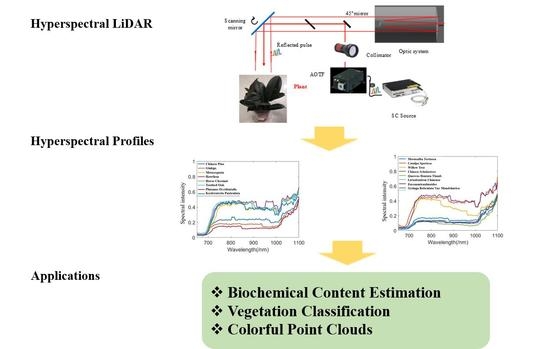Hyperspectral LiDAR-Based Plant Spectral Profiles Acquisition: Performance Assessment and Results Analysis
Abstract
:1. Introduction
- (1)
- for the demand of the vegetation spectral profiles and spectral parameters acquirement in precision agriculture, we presented a practical HSL design; spectral profiles with 10 nm spectral resolution covering 500~1000 nm were acquired; and the spectral parameters widely used in precision agriculture for vegetation status monitoring were extracted and assessed.
- (2)
- for the demand of vegetation classification in precision agriculture, based on spectral parameters results, the vegetation sample leaves classification results using the spectral parameters as the input features of a designed support vector machine (SVM) classifier with multiple labels were presented, and the feasibility was assessed.
- (3)
- in view of the HSL laser intensity related to the laser transmitting distance and incident angle, the influence of the laser beam incident angle on the spectral parameters calculation was analyzed; the results showed that the spectral parameters with “(A − B)/(A + B)” and “A/B” were independent with the laser beam incident angle.
2. HSL Design and Vegetation Spectral Indexes
2.1. HSL Design
- (1)
- the first component is the laser source. In this HSL, the SC source is employed for generating “white” laser pulse, and the spectral band ranges from approximately 450 nm to 2500 nm [22];
- (2)
- the second component is the wavelength selecting or filtering device. After the laser source emitting the supercontinuum laser beam, a wavelength selecting device is installed after it for filtering the passing laser beam; in this HSL design, an AOTF is utilized as the wavelength selection device, and more specifications or parameters of the AOTF are available in our previously published paper [22]; additionally, after the wavelength selecting operation, a collimator is employed for guaranteeing the collimation of the laser beam;
- (3)
- the third component is the optical system, which steers the laser beam to the target and collects the reflected laser pulse from the target. The reflected pulse is detected by a silicon-based avalanche photodiode (APD). The data are then sampled by a connected high-speed oscilloscope (20 G per second), and the spectral reflectance is derived from the collected raw reflected waveform signals.
2.2. Vegetation Indexes and Parameters
3. Laser Radiation Model
3.1. Laser Intensity Model
3.2. Spectral Parameters Extraction Using Whiteboard as Reference
- (a)
- Spectral Parameters with “(A − B)/(A + B)” formula
- (b)
- Spectral Parameters with “A/B” formulas
4. Results
4.1. Experiment #01—Spectral Indexed Results Comparison
4.1.1. Green Leaf Results
4.1.2. Yellow Leaf Results Analysis
4.2. Experiment #02—Vegetation Leaves Classification
4.3. Experiment #03—Influence of the Incident Angle Analysis on Spectral Indexes Results
5. Discussion
- (1)
- The first reason was that the vegetation yielded low reflectivity in the spectral band 500~700 nm, and the small changes or difference would be relatively large in proportion;
- (2)
- The second reason was that the reflectance of 500~700 nm was employed as the denominator for determining the parameters. For instance, the WI index demonstrated high similarity since the employed spectral wavelength had high reflected intensities; small difference or fluctuations in spectral reflectance was relatively a small proportion; in fact, HSL and SVC yielded minor difference within the 700 nm~1000 nm spectral wavelength for the four green leaves, but the high reflectivity yielded a difference in just a small proportion and almost had no influence on the parameters results.
- (1)
- The power of the received laser pulse was affected by many factors. In Figure 3, these NDVI and WI results were calculated with the distance fixed and the incident angle changed. As analyzed in Equations (18) and (21), some other factors also affected the NDVI and WI results.
- (2)
- The NDVI and WI results difference between the HSL and spectrometer varied at different incident angles, which might be caused by the noises contained in the HSL raw waveforms. Here, no de-noising or calibration operation conducted for the raw HSL measurements was carried out.
- (1)
- For the green leaves spectral profiles, we found that low reflectivity spectral bands (500~700 nm) demonstrated comparatively different spectral reflectance values (Figure 4b, Figure 5b, Figure 6b and Figure 7b); these fluctuations of the AOTF-HSL spectral profiles affected the difference; the fluctuations might be caused by the noise contained in the raw measurements in the HSL. A filtering scheme (Gaussian fitting) or better HSL setting-up might be effective for bettering the results.
- (2)
- The HSL employed in this paper owned a 10 nm spectral resolution; it was comparatively better than previous HSL, but the spectral resolution of SVC spectrometer was better than 10 nm, and the low spectral resolution partially accounted for the AOTF-HSL spectral profiles fluctuations (Figure 4b, Figure 5b, Figure 6b and Figure 7b); it was of great significance for developing HSL with finer resolution, and it would bring new, interesting results for vegetation spectral indexes determination.
- (3)
- The spectral data in this experiment were collected at the fixed distance, and a proper calibration method or solution was essential for calibrating the HSL while collecting the spectral profiles with different distance and incident angles. In other words, the incident angle effect on the HSL should be investigated.
- (4)
- In this paper, the HSL just scanned one point for each leaf, and the laser beam footprint was comparatively large. For 3D imaging of the vegetation spectral indexes distribution, HSL with narrow field of view resulting in higher spatial resolution was of great significance for extending the application.
- (5)
- Based on this HSL, a classic multi-label SVM classifier was designed and employed for tree leaves classification; a simple classifier could reach satisfactory classification accuracy. We thought two major reasons might account for these phenomena: the experiment was carried out in the lab with a controlled environment with almost no external factors that could affect the HSL collecting the spectral profiles of the leaves; the leaves employed in the experiment are all green leaves, which has uniform distribution of the biological contents.
- (6)
- Calibration of the HSL should be carried out and some intrinsic and extrinsic factors should be modeled, which was helpful to improve the HSL measurements. There must be noises contained in the HSL raw waveforms; appropriate de-noising methods should be investigated.
6. Conclusions
- (1)
- This paper presented a practical HSL design suitable for precision agriculture applications.
- (2)
- The consistency of green leaves spectral indexes results extracted from both the SVC and the HSL demonstrates that the AOTF-HSL with current settings was feasible and executable for vegetation spectral profiles acquirement.
- (3)
- This paper investigated the incident angle effect on the spectral indexes determination; we found that the incident angle had no influence on the spectral parameters with “(A − B)/(A + B)” and “A/B” styles.
Author Contributions
Funding
Informed Consent Statement
Data Availability Statement
Acknowledgments
Conflicts of Interest
References
- Asra, G. Theory and Applications of Optical Remote Sensing; Asrar, G., Ed.; Wiley: New York, NY, USA, 1989. [Google Scholar]
- Ceccato, P.; Gobron, N.; Flasse, S.; Pinty, B.; Tarantola, S. Designing a spectral index to estimate vegetation water content from remote sensing data: Part 1: Theoretical approach. Remote Sens. Environ. 2002, 82, 188–197. [Google Scholar] [CrossRef]
- Turner, W.; Spector, S.; Gardiner, N.; Fladeland, M.; Sterling, E.; Steininger, M. Remote sensing for biodiversity science and conservation. Trends Ecol. Evol. 2003, 18, 306–314. [Google Scholar] [CrossRef]
- Verrelst, J.; Camps-Valls, G.; Muñoz-Marí, J.; Rivera, J.P.; Veroustraete, F.; Clevers, J.G.; Moreno, J. Optical remote sensing and the retrieval of terrestrial vegetation bio-geophysical properties—A review. ISPRS J. Photogramm. Remote Sens. 2015, 108, 273–290. [Google Scholar] [CrossRef]
- Nevalainen, O.; Hakala, T.; Suomalainen, J.; Mäkipää, R.; Peltoniemi, M.; Krooks, A.; Kaasalainen, S. Fast and nondestructive method for leaf level chlorophyll estimation using hyperspectral LiDAR. Agric. For. Meteorol. 2014, 198, 250–258. [Google Scholar] [CrossRef]
- Zhou, H.; Chen, Y.; Feng, Z.; Li, F.; Hyyppä, J.; Hakala, T.; Karjalainen, M.; Jiang, C.; Pei, L. The comparison of canopy height profiles extracted from Ku-band profile radar waveforms and LiDAR data. Remote Sens. 2018, 10, 701. [Google Scholar] [CrossRef] [Green Version]
- Danson, F.M.; Gaulton, R.; Armitage, R.P.; Disney, M.; Gunawan, O.; Lewis, P.; Pearson, G.; Ramirez, A.F. Developing a dual-wavelength full-waveform terrestrial laser scanner to characterize forest canopy structure. Agric. For. Meteorol. 2014, 198, 7–14. [Google Scholar] [CrossRef] [Green Version]
- Eitel, J.U.; Höfle, B.; Vierling, L.A.; Abellán, A.; Asner, G.P.; Deems, J.S.; Mandlburger, G. Beyond 3-D: The new spectrum of lidar applications for earth and ecological sciences. Remote Sens. Environ. 2016, 186, 372–392. [Google Scholar] [CrossRef] [Green Version]
- Li, W.; Sun, G.; Niu, Z.; Gao, S.; Qiao, H. Estimation of leaf biochemical content using a novel hyperspectral full-waveform LiDAR system. Remote Sens. Lett. 2014, 5, 693–702. [Google Scholar] [CrossRef]
- Du, L.; Gong, W.; Shi, S.; Yang, J.; Sun, J.; Zhu, B.; Song, S. Estimation of rice leaf nitrogen contents based on hyperspectral LIDAR. Int. J. Appl. Earth Obs. Geogr. Inf. 2016, 44, 136–143. [Google Scholar] [CrossRef]
- Sun, J.; Shi, S.; Gong, W.; Yang, J.; Du, L.; Song, S.; Zhang, Z. Evaluation of hyperspectral LiDAR for monitoring rice leaf nitrogen by comparison with multispectral LiDAR and passive spectrometer. Sci. Rep. 2017, 7, 40362. [Google Scholar] [CrossRef]
- Jiang, C.; Chen, Y.; Wu, H.; Li, W.; Zhou, H.; Bo, Y.; Hyyppä, J. Study of a High Spectral Resolution Hyperspectral LiDAR in Vegetation Red Edge Parameters Extraction. Remote Sens. 2019, 11, 2007. [Google Scholar] [CrossRef] [Green Version]
- Suomalainen, J.; Hakala, T.; Kaartinen, H.; Räikkönen, E.; Kaasalainen, S. Demonstration of a virtual active hyperspectral LiDAR in automated point cloud classification. ISPRS J. Photogramm. Remote Sens. 2011, 66, 637–641. [Google Scholar] [CrossRef]
- Kaasalainen, S.; Lindroos, T.; Hyyppa, J. Toward hyperspectral lidar: Measurement of spectral backscatter intensity with a supercontinuum laser source. IEEE Geosci. Remote Sens. Lett. 2007, 4, 211–215. [Google Scholar] [CrossRef]
- Chen, Y.; Räikkönen, E.; Kaasalainen, S.; Suomalainen, J.; Hakala, T.; Hyyppä, J.; Chen, R. Two-channel hyperspectral LiDAR with a supercontinuum laser source. Sensors 2010, 10, 7057–7066. [Google Scholar] [CrossRef] [Green Version]
- Hakala, T.; Suomalainen, J.; Kaasalainen, S.; Chen, Y. Full waveform hyperspectral LiDAR for terrestrial laser scanning. Opt. Express 2012, 20, 7119–7127. [Google Scholar] [CrossRef]
- Vauhkonen, J.; Hakala, T.; Suomalainen, J.; Kaasalainen, S.; Nevalainen, O.; Vastaranta, M.; Hyyppä, J. Classification of spruce and pine trees using active hyperspectral LiDAR. IEEE Geosci. Remote Sens. Lett. 2013, 10, 1138–1141. [Google Scholar] [CrossRef]
- Li, W.; Niu, Z.; Sun, G.; Gao, S.; Wu, M. Deriving backscatter reflective factors from 32-channel full-waveform LiDAR data for the estimation of leaf biochemical contents. Opt. Express 2016, 24, 4771–4785. [Google Scholar] [CrossRef]
- Wang, Z.; Chen, Y.; Li, C.; Tian, M.; Zhou, M.; He, W.; Zhou, H. A Hyperspectral LiDAR with Eight Channels Covering from VIS to SWIR. In Proceedings of the IGARSS 2018–2018 IEEE International Geoscience and Remote Sensing Symposium, Valencia, Spain, 22–27 July 2018; pp. 4293–4296. [Google Scholar]
- Li, W.; Jiang, C.; Chen, Y.; Hyyppä, J.; Tang, L.; Li, C.; Wang, S.W. A Liquid Crystal Tunable Filter-Based Hyperspectral LiDAR System and Its Application on Vegetation Red Edge Detection. IEEE Geosci. Remote Sens. Lett. 2019, 16, 291–295. [Google Scholar] [CrossRef]
- Chen, Y.; Jiang, C.; Hyyppä, J.; Qiu, S.; Wang, Z.; Tian, M.; Bo, Y. Feasibility Study of Ore Classification Using Active Hyperspectral LiDAR. IEEE Geosci. Remote Sens. Lett. 2018, 99, 1–5. [Google Scholar] [CrossRef]
- Chen, Y.; Li, W.; Hyyppä, J.; Wang, N.; Jiang, C.; Meng, F.; Li, C. A 10-nm Spectral Resolution Hyperspectral LiDAR System Based on an Acousto-Optic Tunable Filter. Sensors 2019, 19, 1620. [Google Scholar] [CrossRef] [Green Version]
- Shao, H.; Chen, Y.; Yang, Z.; Jiang, C.; Li, W.; Wu, H.; Wang, S.; Yang, F.; Chen, J.; Puttonen, E.; et al. Feasibility Study on Hyperspectral LiDAR for Ancient Huizhou-Style Architecture Preservation. Remote Sens. 2020, 12, 88. [Google Scholar] [CrossRef] [Green Version]
- Shao, H.; Chen, Y.; Yang, Z.; Jiang, C.; Li, W.; Wu, H.; Wen, Z.; Wang, S.; Puttnon, E.; Hyyppä, J. A 91-Channel Hyperspectral LiDAR for Coal/Rock Classification. IEEE Geosci. Remote Sens. Lett. 2020, 17, 1052–1056. [Google Scholar] [CrossRef] [Green Version]
- Malkamäki, T.; Kaasalainen, S.; Ilinca, J. Portable hyperspectral lidar utilizing 5 GHz multichannel full waveform digitization. Opt. Express 2019, 27, A468–A480. [Google Scholar] [CrossRef]
- Peñuelas, J.; Pinol, J.; Ogaya, R.; Filella, I. Estimation of plant water concentration by the reflectance water index WI (R900/R970). Int. J. Remote Sens. 1997, 18, 2869–2875. [Google Scholar] [CrossRef]
- Carlson, T.N.; Ripley, D.A. On the relation between NDVI, fractional vegetation cover, and leaf area index. Remote Sens. Environ. 1997, 62, 241–252. [Google Scholar] [CrossRef]
- Eitel, J.U.; Vierling, L.A.; Litvak, M.E.; Long, D.S.; Schulthess, U.; Ager, A.A.; Stoscheck, L. Broadband, red-edge information from satellites improves early stress detection in a New Mexico conifer woodland. Remote Sens. Environ. 2011, 115, 3640–3646. [Google Scholar] [CrossRef]
- Wu, C.; Niu, Z.; Tang, Q.; Huang, W.; Rivard, B.; Feng, J. Remote estimation of gross primary production in wheat using chlorophyll-related vegetation indices. Agric. For. Meteorol. 2009, 149, 1015–1021. [Google Scholar] [CrossRef]
- Jiang, C.; Chen, Y.; Tian, W.; Feng, Z.; Li, W.; Zhou, C.; Shao, H.; Puttonen, E.; Hyyppä, J. A practical method utilizing multi-spectral LiDAR to aid points cloud matching in SLAM. Satell. Navig. 2020, 1, 1–11. [Google Scholar] [CrossRef]
- Jiang, C.; Chen, Y.; Tian, W.; Wu, H.; Li, W.; Zhou, H.; Shao, H.; Song, S.; Puttonen, E.; Hyyppä, J. A practical method for employing multi-spectral LiDAR intensities in points cloud classification. Int. J. Remote Sens. 2020, 41, 8366–8379. [Google Scholar] [CrossRef]
- Pearson Correlation Coefficient. Available online: https://en.wikipedia.org/wiki/Pearson_correlation_coefficient (accessed on 14 June 2021).
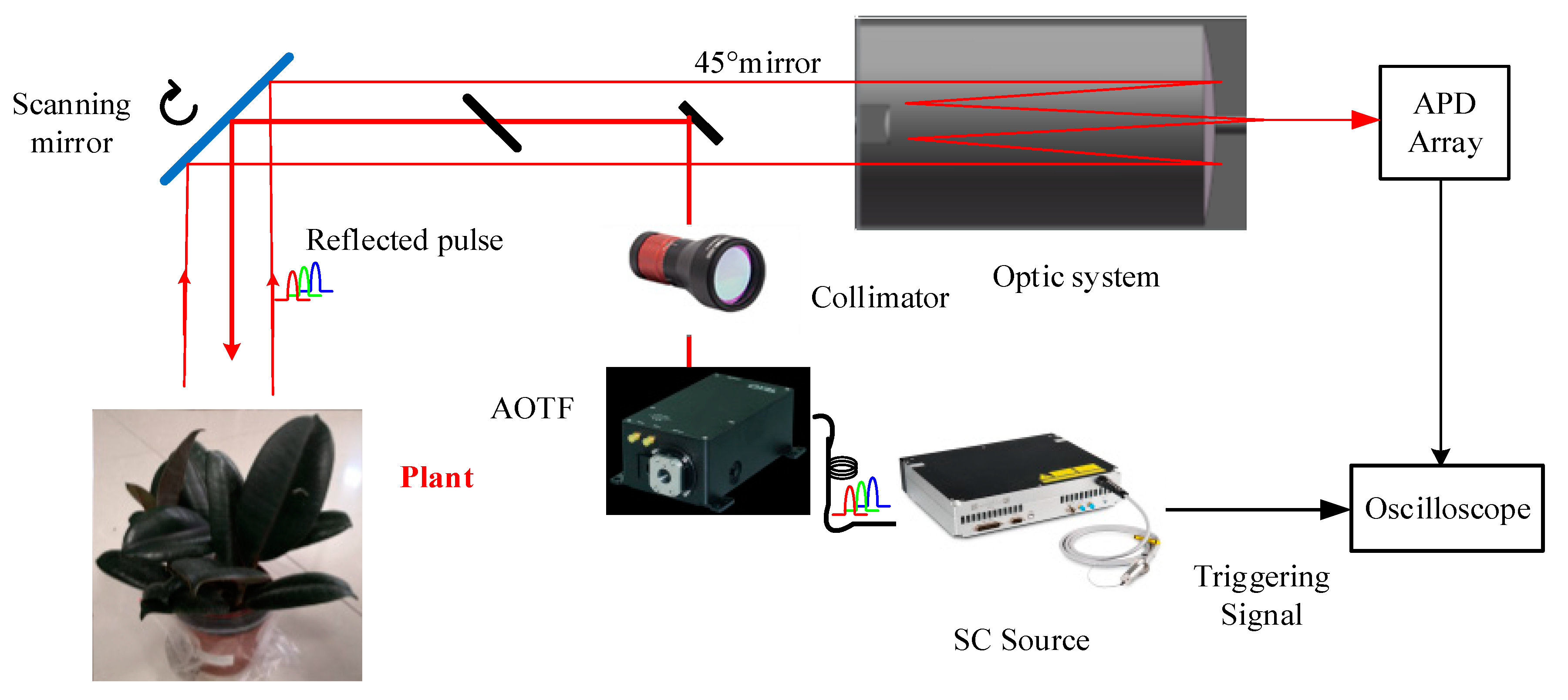
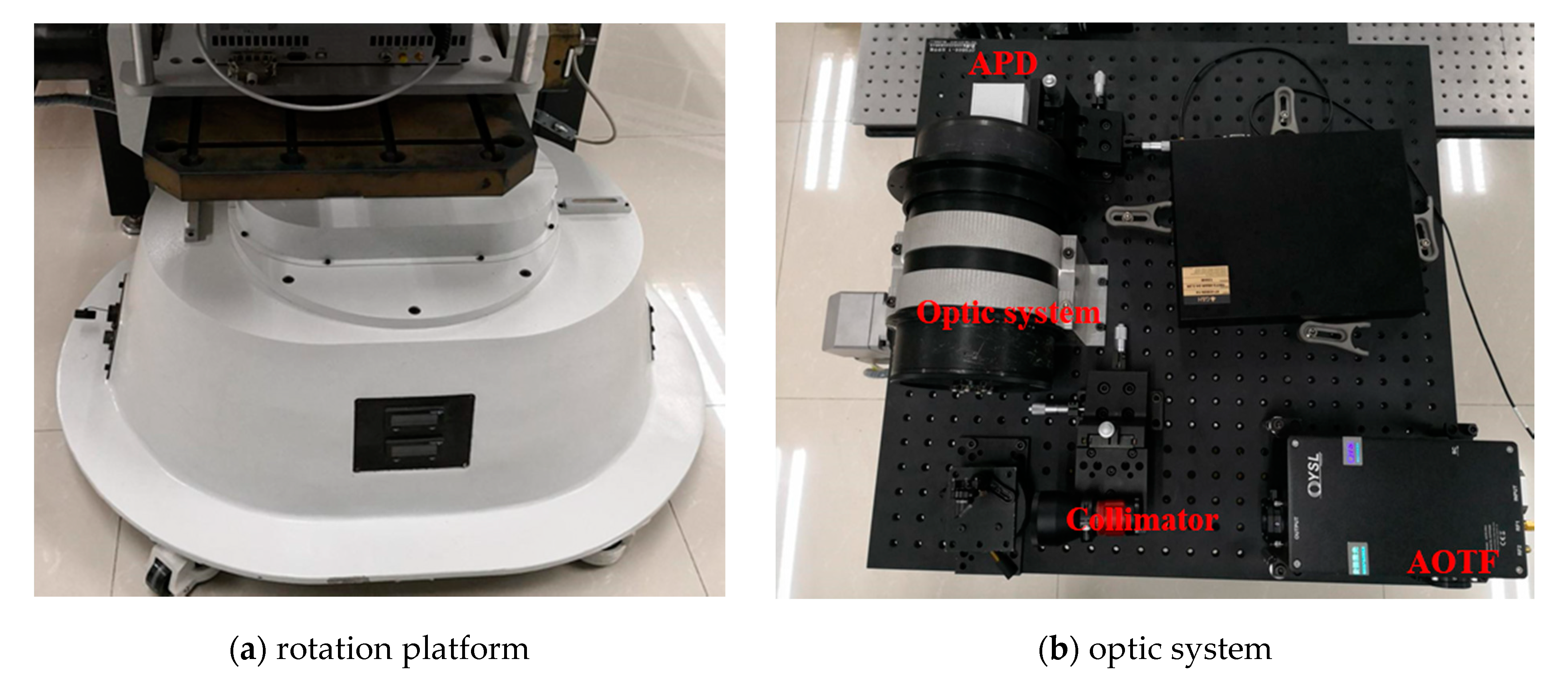
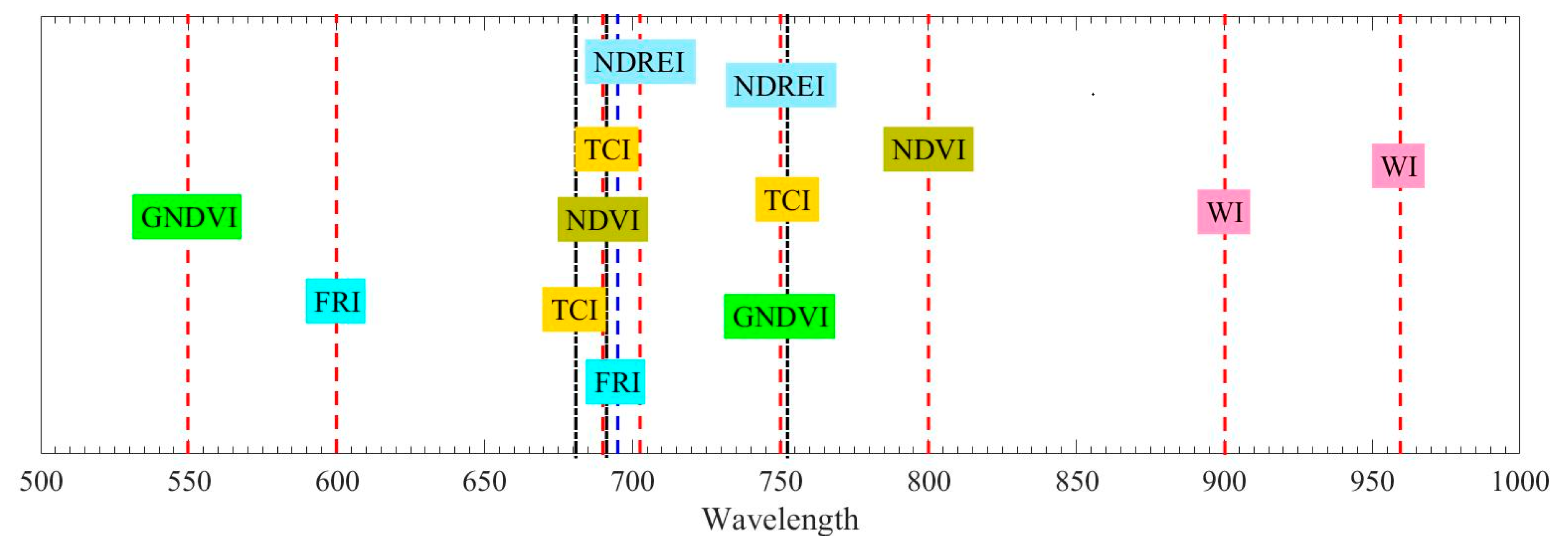
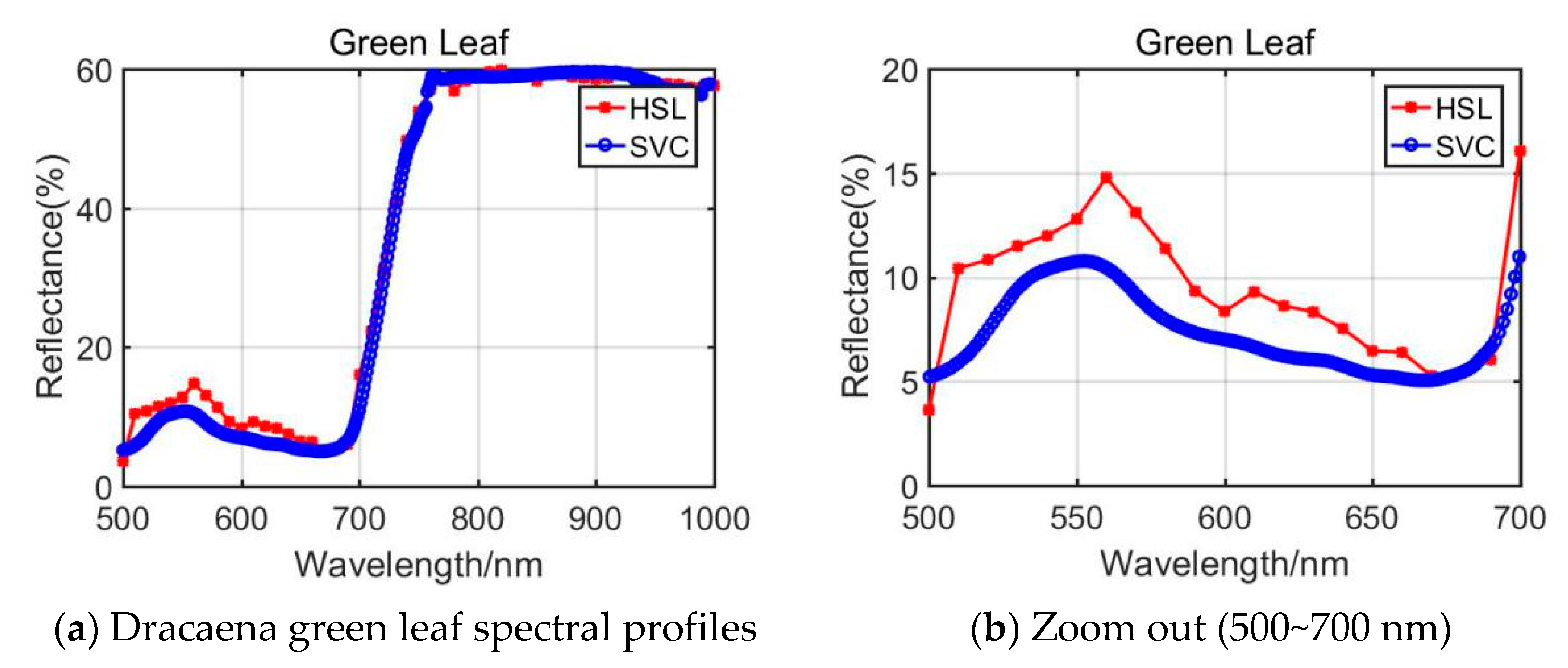
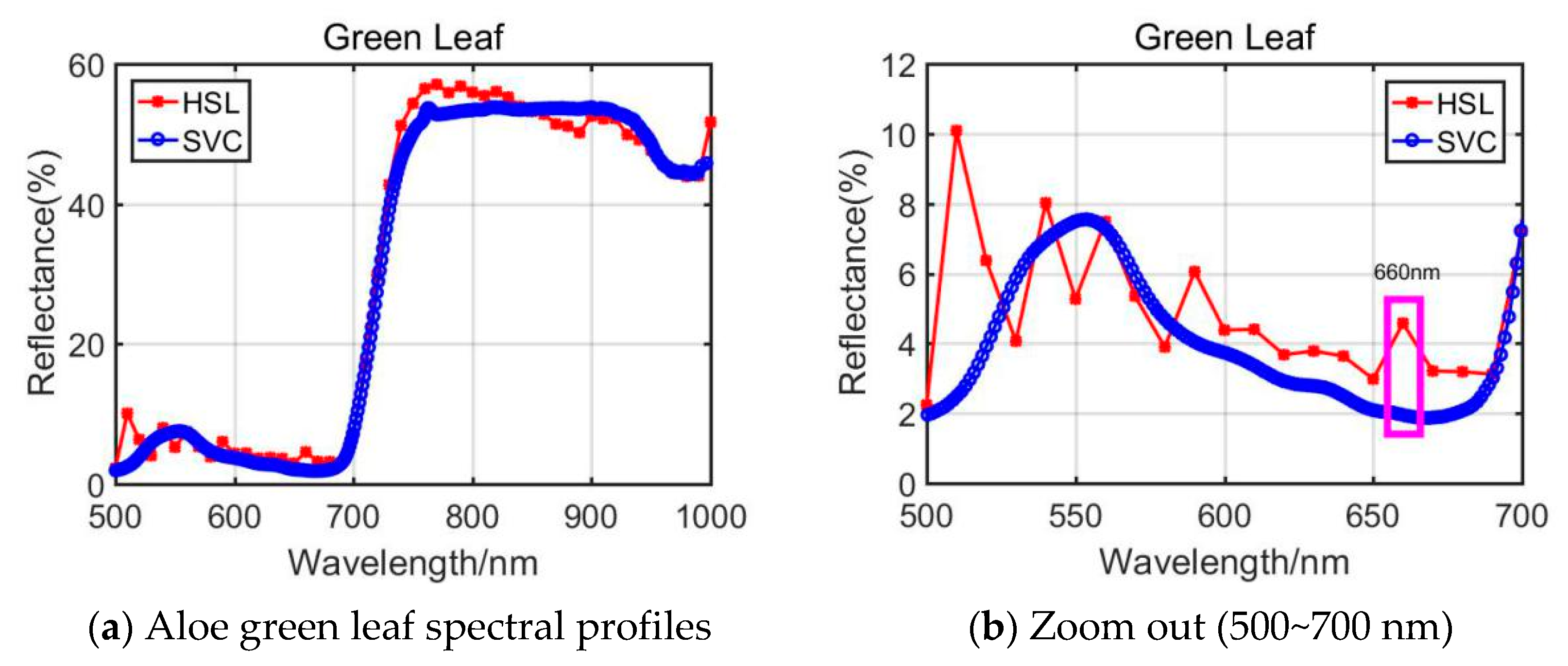

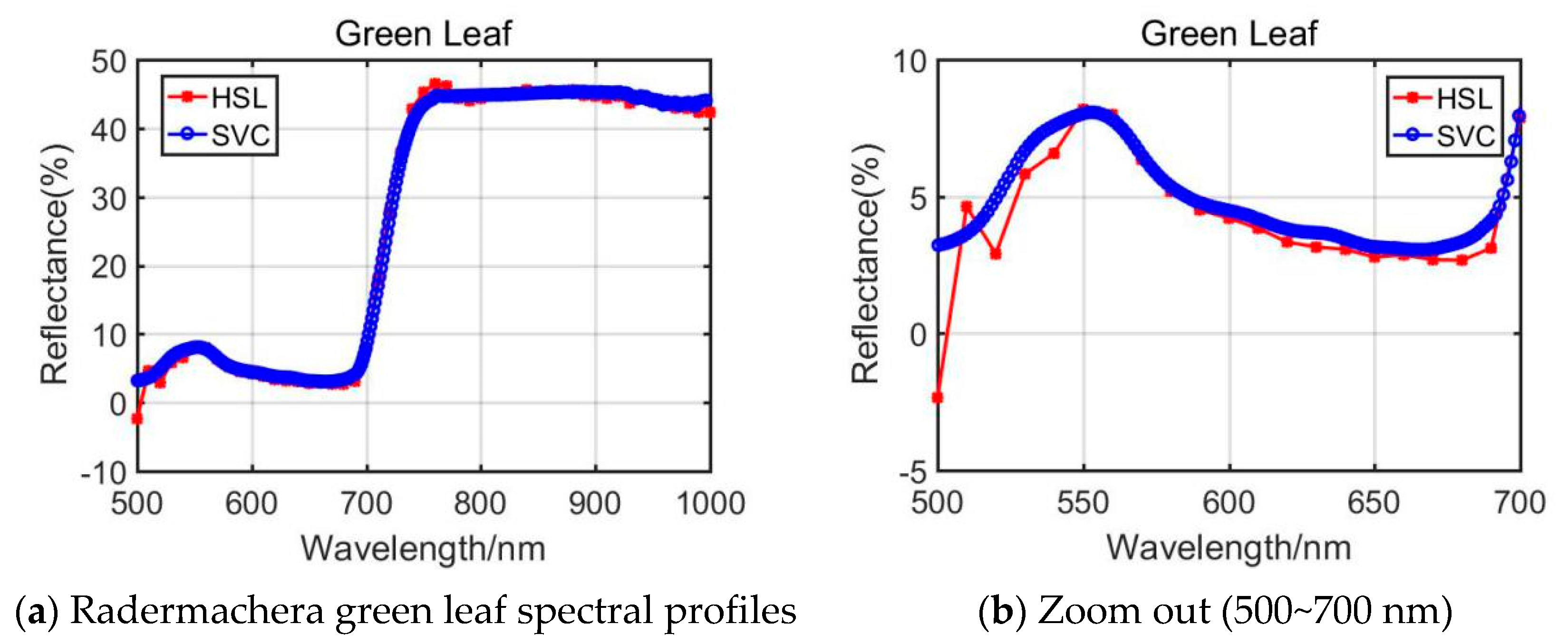

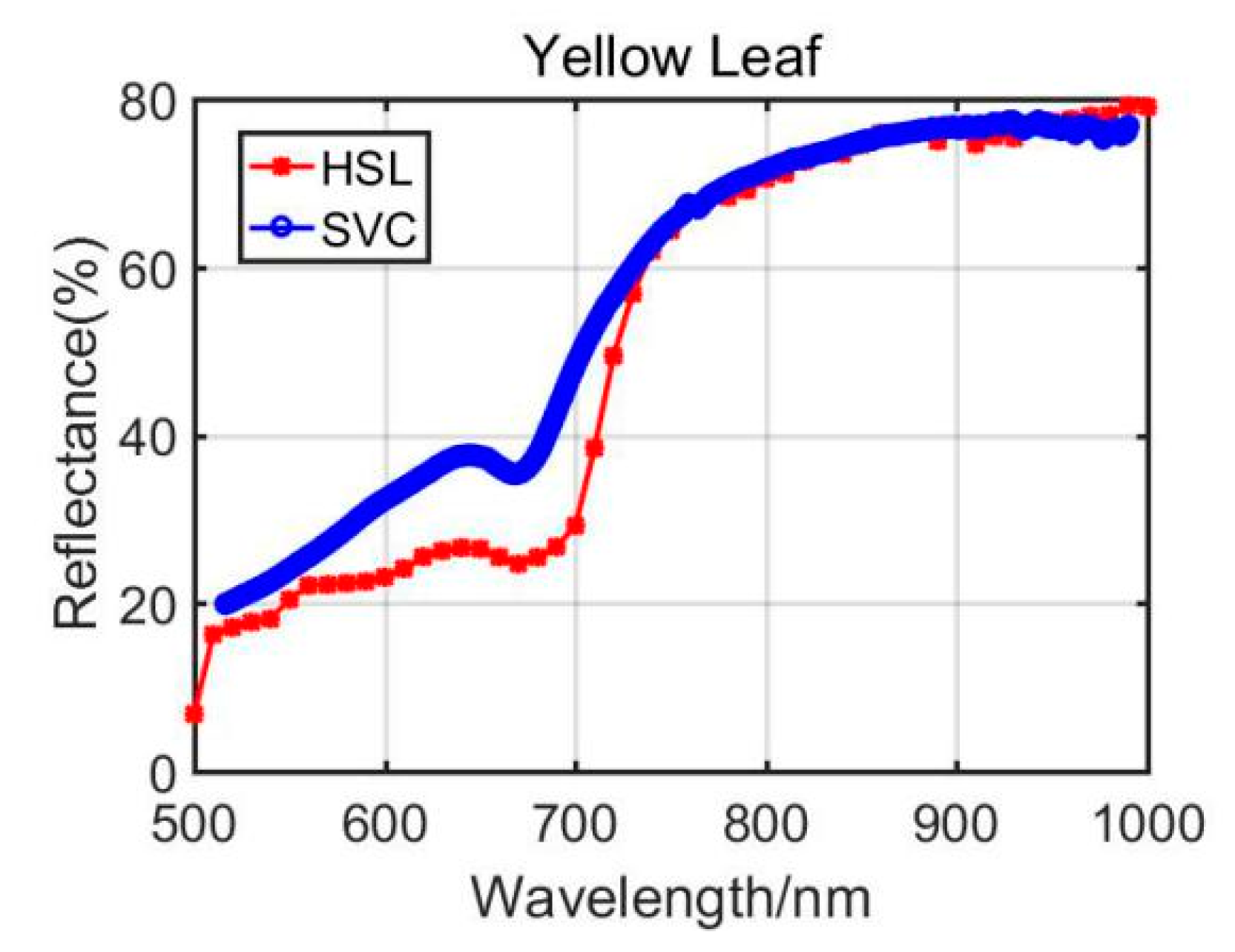
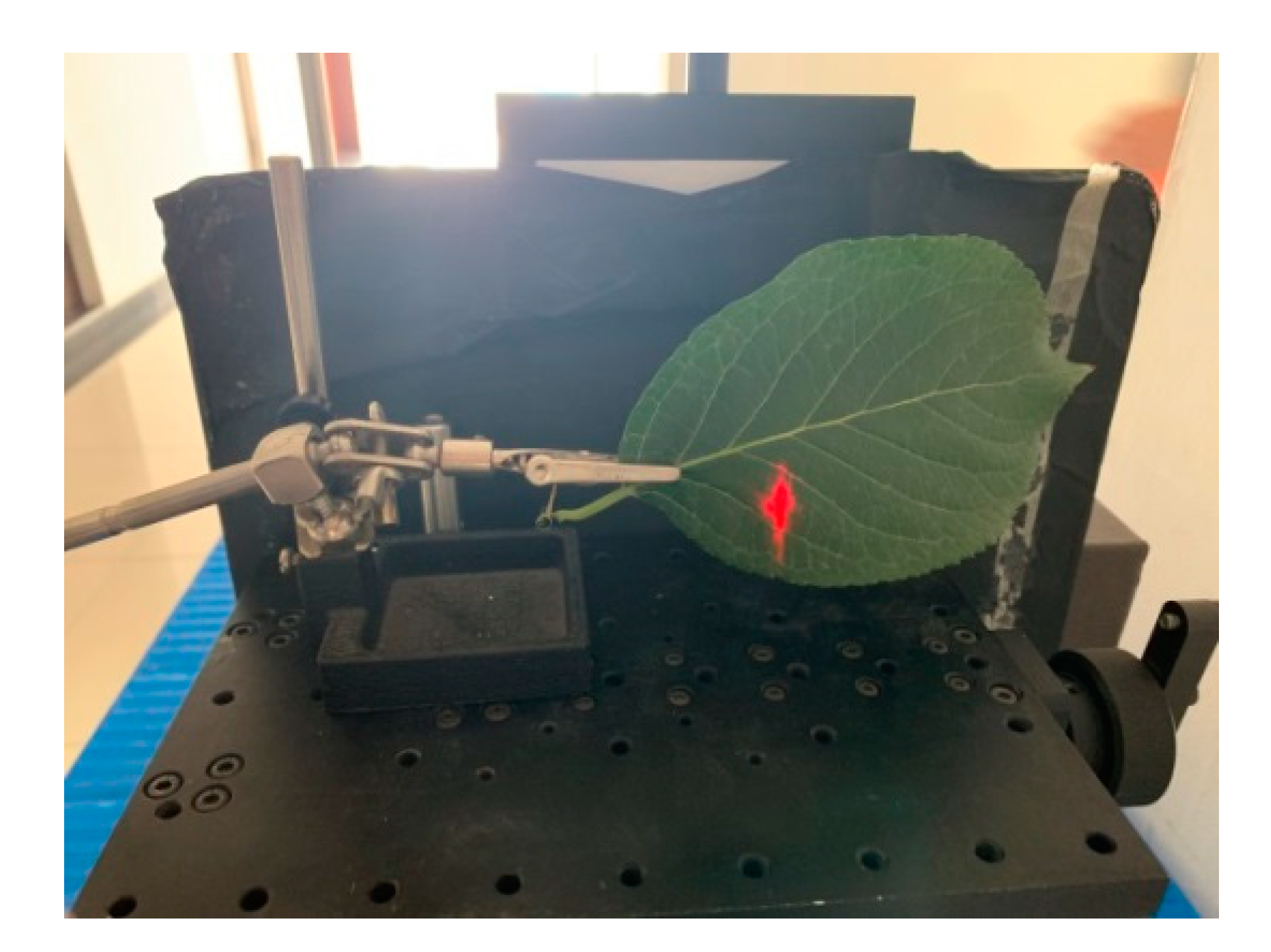


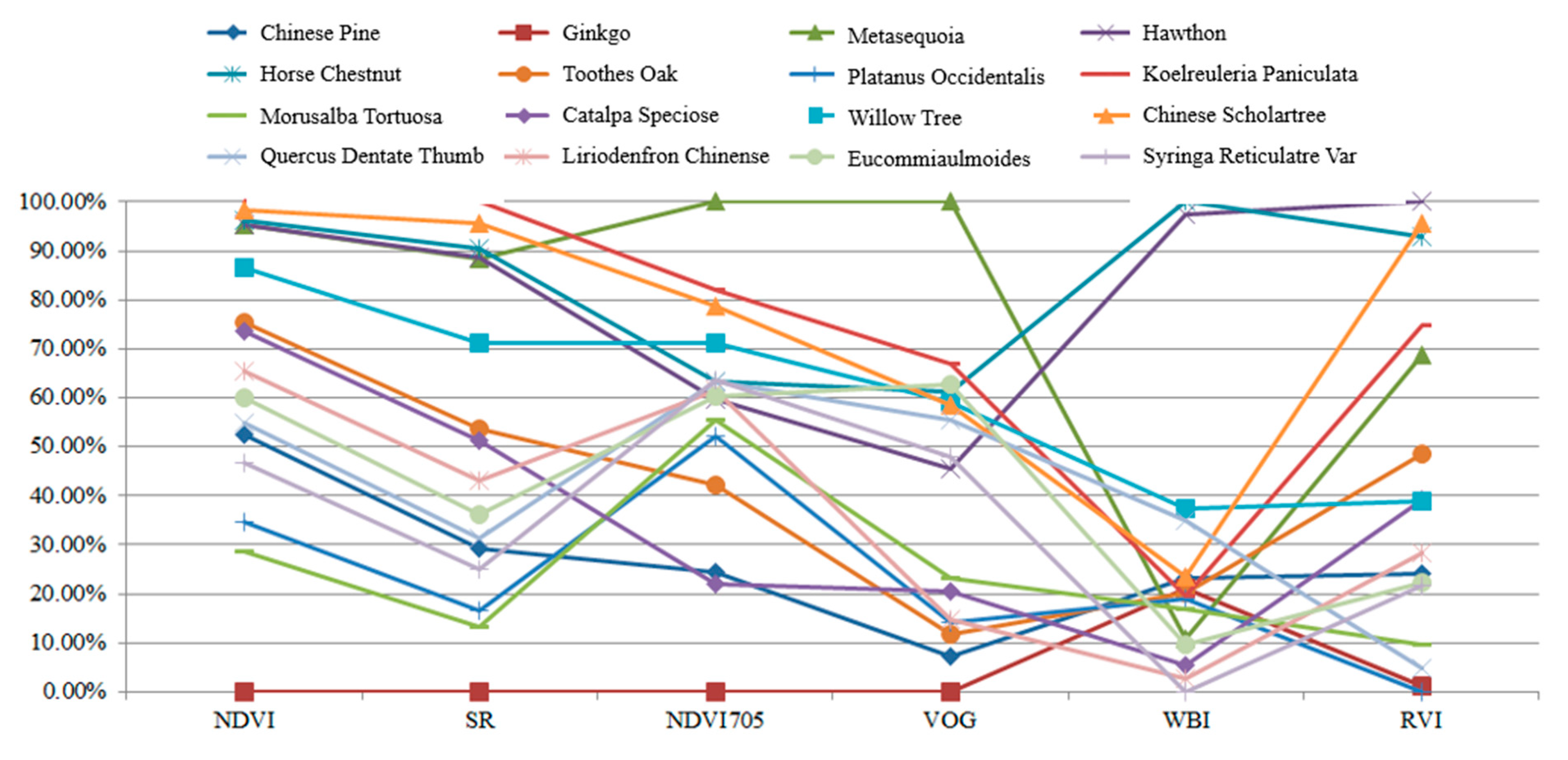



| Year | Spectral Range | Channels | Reference |
|---|---|---|---|
| 2007 | \ | 1 | [14] |
| 2010 | 600~800 nm | 2 | [15] |
| 2012 | 500~1000 nm | 8 | [16] |
| 2016 | 400~1000 nm | 32 (16 nm spectral resolution) | [18] |
| 2018 | 500~1600 nm | 17 | [19] |
| 2018 | 550~720 nm | 18 (10 nm spectral resolution) | [21] |
| 2019 | 500~1000 nm | 51 (10 nm spectral resolution) | [22] |
| 2019 | 650~1100 nm | 91(5 nm Spectral Resolution) | [24] |
| Vegetation Index | Spectral Wavelength | Element | Reference |
|---|---|---|---|
| Water index | 970 nm, 900 nm | water | [24] |
| NDVI | 680 nm, 800 nm | nutrition | [25] |
| GNDVI | 750 nm, 550 nm | nutrition | [25] |
| TCI | 753.53 nm, 708.75 nm, 681.25 nm | chlorophyll | [26] |
| NDREI | 750 nm, 705 nm | chlorophyll | [27] |
| RVI | 870 nm, 660 nm | nutrition | [28] |
| FRI | 600 nm, 690 nm | chlorophyll | [29] |
| Parameters | HSL | SVC | Difference | |
|---|---|---|---|---|
| WI | Dracaena Green Leaf | 0.99 | 0.95 | 4.04% |
| Aloe Green Leaf | 0.84 | 0.83 | 1.19% | |
| Rubber Tree Green Leaf | 0.91 | 0.92 | −1.10% | |
| Radermachera Green Leaf | 0.96 | 0.97 | −1.04% | |
| NDVI | Dracaena Green Leaf | 0.83 | 0.83 | 0.1% |
| Aloe Green Leaf | 0.89 | 0.93 | −3.8% | |
| Rubber Tree Green Leaf | 0.88 | 0.90 | −1.9% | |
| Radermachera Green Leaf | 0.89 | 0.86 | 2.7% | |
| GNDVI | Dracaena Green Leaf | 0.62 | 0.66 | −6.6% |
| Aloe Green Leaf | 0.82 | 0.74 | 10.1% | |
| Rubber Tree Green Leaf | 0.86 | 0.88 | −2.2% | |
| Radermachera Green Leaf | 0.69 | 0.69 | 0.8% | |
| TCI | Dracaena Green Leaf | 1.87 | 2.56 | −36.8% |
| Aloe Green Leaf | 2.64 | 2.69 | −1.9% | |
| Rubber Tree Green Leaf | 4.93 | 6.54 | −32.7% | |
| Radermachera Green Leaf | 1.82 | 2.25 | −23.7% | |
| NDREI | Dracaena Green Leaf | 0.48 | 0.54 | −12.5% |
| Aloe Green Leaf | 0.63 | 0.62 | 1.6% | |
| Rubber Tree Green Leaf | 0.72 | 0.79 | −9.7% | |
| Radermachera Green Leaf | 0.56 | 0.56 | 0.0% | |
| RVI | Dracaena Green Leaf | 9.27 | 11.60 | −25.2% |
| Aloe Green Leaf | 11.23 | 27.66 | 146.3% | |
| Rubber Tree Green Leaf | 16.36 | 23.62 | 44.4% | |
| Radermachera Green Leaf | 15.85 | 14.70 | 7.3% | |
| FRI | Dracaena Green Leaf | 1.39 | 1.05 | 24.1% |
| Aloe Green Leaf | 1.40 | 1.23 | 12.2% | |
| Rubber Tree Green Leaf | 1.02 | 0.76 | −25.5% | |
| Radermachera Green Leaf | 1.35 | 1.08 | 20.0% |
| Parameters | HSL | SVC | Difference | |
|---|---|---|---|---|
| WI | Dracaena Green Leaf | 0.99 | 0.95 | 4.04% |
| Dracaena Yellow Leaf | 1.02 | 1.00 | 1.96% | |
| Aloe Green Leaf | 0.84 | 0.83 | 1.19% | |
| Aloe Yellow Leaf | 0.96 | 0.97 | −1.04% | |
| NDVI | Dracaena Green Leaf | 0.83 | 0.83 | 0.1% |
| Dracaena Yellow Leaf | 0.35 | 0.08 | 77.8% | |
| Aloe Green Leaf | 0.89 | 0.93 | −3.8% | |
| Aloe Yellow Leaf | 0.47 | 0.20 | 56.8% | |
| GNDVI | Dracaena Green Leaf | 0.62 | 0.66 | −6.6% |
| Dracaena Yellow Leaf | 0.35 | 0.15 | 57.0% | |
| Aloe Green Leaf | 0.82 | 0.74 | 10.1% | |
| Aloe Yellow Leaf | 0.52 | 0.44 | 15.7% | |
| TCI | Dracaena Green Leaf | 1.87 | 2.56 | −36.8% |
| Dracaena Yellow Leaf | 0.18 | 1.66 | −822.2% | |
| Aloe Green Leaf | 2.64 | 2.69 | −1.9% | |
| Aloe Yellow Leaf | 1.99 | 0.98 | 50.8% | |
| NDREI | Dracaena Green Leaf | 0.48 | 0.54 | −12.5% |
| Dracaena Yellow Leaf | 0.05 | 0.03 | 40.0% | |
| Aloe Green Leaf | 0.63 | 0.62 | 1.6% | |
| Aloe Yellow Leaf | 0.31 | 0.12 | 61.3% | |
| RVI | Dracaena Green Leaf | 9.27 | 11.60 | −25.2% |
| Dracaena Yellow Leaf | 2.08 | 2.00 | 4.1% | |
| Aloe Green Leaf | 11.23 | 27.66 | 146.3% | |
| Aloe Yellow Leaf | 2.98 | 2.00 | 32.9% | |
| FRI | Dracaena Green Leaf | 1.39 | 1.05 | 24.1% |
| Dracaena Yellow Leaf | 0.86 | 0.64 | 26.1% | |
| Aloe Green Leaf | 1.40 | 1.23 | 12.2% | |
| Aloe Yellow Leaf | 0.87 | 0.66 | 23.5% |
| NDVI | SR | NDVI705 | VOG | WI | RVI | |
|---|---|---|---|---|---|---|
| Chinese Pine | 0.7894 | 8.4986 | 0.4244 | 1.4030 | 1.0949 | 6.2322 |
| Ginkgo | 0.6878 | 5.4058 | 0.3398 | 1.3400 | 1.0895 | 4.4384 |
| Metasequoia | 0.8727 | 0.3398 | 0.6886 | 2.2356 | 1.0659 | 9.7278 |
| Hawthorn | 0.8729 | 14.7369 | 0.5480 | 1.7484 | 1.2682 | 12.1753 |
| Horse Chestnut | 0.8746 | 14.9474 | 0.5605 | 1.8880 | 1.2745 | 11.6309 |
| Toothes Oak | 0.8341 | 11.0533 | 0.4868 | 1.4453 | 1.0875 | 8.1513 |
| Platanus Occidentalis | 0.7550 | 7.1632 | 0.5215 | 1.4672 | 1.0847 | 4.3583 |
| Koelreuleria Paniculata | 0.8820 | 15.9475 | 0.6260 | 1.9389 | 1.0860 | 10.2124 |
| Morusalba Tortuosa | 0.7434 | 6.7953 | 0.5333 | 1.5470 | 1.0794 | 5.1169 |
| Catalpa Speciose | 0.8306 | 10.8080 | 0.4168 | 1.5226 | 1.0530 | 7.4142 |
| Willow Tree | 0.8561 | 12.8985 | 0.5876 | 1.8701 | 1.1279 | 7.3945 |
| Chinese Scholar Tree | 0.8787 | 15.4825 | 0.6140 | 1.8646 | 1.0952 | 11.8217 |
| Quercus Dentate Thunb | 0.7941 | 8.7140 | 0.5606 | 1.8369 | 1.1223 | 4.7415 |
| Liriodenfron Chinense | 0.8147 | 9.9530 | 0.5541 | 1.4711 | 1.0468 | 6.5760 |
| Eucommia Ulmoides | 0.8042 | 9.2139 | 0.5498 | 1.9005 | 1.0627 | 6.1059 |
| Syringa Reticulate Var. | 0.7788 | 8.0398 | 0.5618 | 1.7679 | 1.0403 | 6.0578 |
| Leaf | Accuracy (%) | Leaf | Accuracy (%) |
|---|---|---|---|
| Chinese Pine | 100% | Morusalba Tortuosa | 100% |
| Ginkgo | 100% | Catalpa Speciose | 100% |
| Metasequoia | 100% | Willow Tree | 100% |
| Hawthorn | 100% | Chinese Scholar Tree | 100% |
| Horse Chestnut | 100% | Quercus Dentate Thunb | 100% |
| Toothes Oak | 100% | Liriodenfron chinense | 100% |
| Platanus Occidentalis | 100% | Eucommia Ulmoides | 100% |
| Koelreuleria Paniculata | 100% | Syringa Reticulate Var. | 100% |
Publisher’s Note: MDPI stays neutral with regard to jurisdictional claims in published maps and institutional affiliations. |
© 2021 by the authors. Licensee MDPI, Basel, Switzerland. This article is an open access article distributed under the terms and conditions of the Creative Commons Attribution (CC BY) license (https://creativecommons.org/licenses/by/4.0/).
Share and Cite
Jia, J.; Jiang, C.; Li, W.; Wu, H.; Chen, Y.; Hu, P.; Shao, H.; Wang, S.; Yang, F.; Puttonen, E.; et al. Hyperspectral LiDAR-Based Plant Spectral Profiles Acquisition: Performance Assessment and Results Analysis. Remote Sens. 2021, 13, 2521. https://doi.org/10.3390/rs13132521
Jia J, Jiang C, Li W, Wu H, Chen Y, Hu P, Shao H, Wang S, Yang F, Puttonen E, et al. Hyperspectral LiDAR-Based Plant Spectral Profiles Acquisition: Performance Assessment and Results Analysis. Remote Sensing. 2021; 13(13):2521. https://doi.org/10.3390/rs13132521
Chicago/Turabian StyleJia, Jianxin, Changhui Jiang, Wei Li, Haohao Wu, Yuwei Chen, Peilun Hu, Hui Shao, Shaowei Wang, Fan Yang, Eetu Puttonen, and et al. 2021. "Hyperspectral LiDAR-Based Plant Spectral Profiles Acquisition: Performance Assessment and Results Analysis" Remote Sensing 13, no. 13: 2521. https://doi.org/10.3390/rs13132521
APA StyleJia, J., Jiang, C., Li, W., Wu, H., Chen, Y., Hu, P., Shao, H., Wang, S., Yang, F., Puttonen, E., & Hyyppä, J. (2021). Hyperspectral LiDAR-Based Plant Spectral Profiles Acquisition: Performance Assessment and Results Analysis. Remote Sensing, 13(13), 2521. https://doi.org/10.3390/rs13132521









